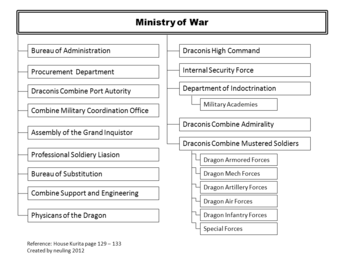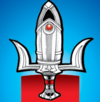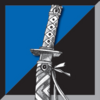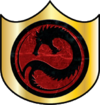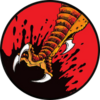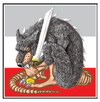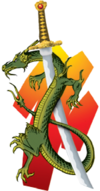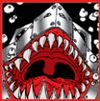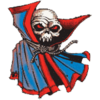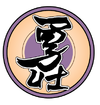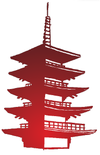Draconis Combine Mustered Soldiery
The Draconis Combine Mustered Soldiery (DCMS) is the military arm of the Draconis Combine. Representing the Pillar of Steel in the Five Pillars which support the Combine, the DCMS is the center around which all life in the Combine revolves. The warriors of the DCMS live by the tenets of bushido, the code of the samurai, and are known as some of the fiercest and most fanatical warriors in the Inner Sphere. Unfortunately these traits have their drawbacks, such as a propensity for brutality (most infamously displayed in the Kentares Massacre) and a rigid adherence to traditional ways of thinking.
Contents
- 1 Structure
- 1.1 High Command
- 1.2 Gunji-no-Kanrei
- 1.3 Military District Commanders
- 1.4 Prefecture Commanders
- 1.5 Ministry of the Expansion of the Glories of the Draconis Combine
- 1.5.1 Department of Indoctrination
- 1.5.2 Bureau of Substitution
- 1.5.3 Assembly of the Grand Inquisitor
- 1.5.4 Procurement Department
- 1.5.5 Draconis Combine Port Authority
- 1.5.6 Bureau of Administration
- 1.5.7 Combine Military Coordination Office
- 1.5.8 Draconis Combine Mustered Soldiery
- 1.5.9 Draconis Combine Admiralty
- 1.5.10 Professional Soldiery Liaison
- 1.5.11 Physicians of the Dragon
- 1.5.12 Combine Support and Engineering
- 1.5.13 Draconis High Command
- 1.5.14 Internal Security Force
- 2 Doctrine
- 3 Organization
- 4 Military Academies
- 5 Military Ranks
- 6 See Also
- 7 Notes
- 8 References
- 9 Bibliography
Structure[edit]
High Command[edit]
The Coordinator of the Draconis Combine is the head of the DCMS, to whom all officers and soldiers swear their undying loyalty and from whom all military decisions originate. They are assisted in carrying out military policy by the Draconis High Command, a small group of officers comprised of the DCMS' Warlords, a select number of other Tai-shos, and their advisers. High Command is responsible for bringing important information to the Coordinator's attention and relaying his (or her) orders to the appropriate authorities to be carried out. Many Coordinators have made it a point to issue general or even vague orders, leaving it to their Warlords to carry them out (and thus suffer the consequences for failing to correctly interpret the Dragon's wishes). The Warlords in turn are in constant struggle with each other to earn the Coordinator's favor and so earn power and prestige.[1][2]
Gunji-no-Kanrei[edit]
The post of Gunji-no-Kanrei (Deputy of Military Affairs), a position superior to that of the Warlords but below the Coordinator, was a largely ceremonial role and typically vacant during the history of the Combine. That significantly changed in 3030 when Coordinator Takashi Kurita appointed his son Theodore Kurita to the position to oversee the rebuilding and restructuring of the DCMS after the Fourth Succession War. As Kanrei, Theodore made a number of reforms, including offering less rigid interpretations of bushido, which angered many old-guard officers; his successes during conflicts including the War of 3039 and Clan Invasion helped cement his role and gave his reforms more weight.[2][3] When Theodore himself became Coordinator in 3054, he allowed the position to become vacant again.[2]
Military District Commanders[edit]
The Military Districts that make up the Combine are ruled by a Tai-shu or Warlord who is in command of all military forces in the district. This includes both Regular units permanently assigned to the district and so-called "free-floating" units currently operating in the theater. Warlords report directly to the Coordinator and wield incredible authority designed to quickly implement the Dragon's wishes; unfortunately such power tends to attract individuals more concerned with their own advancement than serving the Combine. Some Coordinators have gotten around this problem by appointing Warlords with opposing attitudes and ambitions, allowing them to play off one another and so prevent anyone from gaining too much influence. Others, such as Theodore Kurita, compensate by cultivating a closer relationship with lower-ranking senior officers, a move which tempers the Warlords' ambitions and provides a font of information and advice they might not otherwise receive.[2]
Prefecture Commanders[edit]
Each of the military districts are divided into prefectures which are similarly overseen by a military commander. In theory, these prefecture commanders have the same authority to command any military unit operating within their area of operation. In actual practice, the Warlords maintain tight control over these commanders, including going around them altogether to directly issue orders to units, to prevent any threat to their authority. The true purpose of the prefecture system is to quickly stamp out any hint of rebelliousness from the planetary governments operating within the area.[2]
Ministry of the Expansion of the Glories of the Draconis Combine[edit]
The Ministry of War or Hyöbushö is the bureaucracy which manages all aspects of the DCMS. As with the other governmental ministries, it is led by a head minister, with subministers in charge of most departments. However, unlike the other ministries, the department names are purposefully self-explanatory to improve efficiency.[4]
Department of Indoctrination[edit]
Charged with running the military schools which teach children ages 10 to 16 the necessary skills to become "the arms of the Dragon," including a three-week wilderness retreat. Also in charge of the most prestigious military academies in the Combine.[5][6]
Bureau of Substitution[edit]
Handles sending replacements to depleted units and the transfer (without promotion) of soldiers to different units or branches. A shuga-to-hama (letter of joyous celebration) is rarely received well since these transfers typically are the result of antisocial behavior and come with decreased pay and status.[5][6]
Assembly of the Grand Inquisitor[edit]
The Grand Inquisitor is responsible for all judicial cases arising between individual soldiers and the Draconis Combine, including infractions against House Kurita itself or the Dictum Honorium; as such cases heard by the Assembly are rare but it has greater power and can override decisions by the Ministry of Justice. Those brought before the Grand Inquisitor must defend their actions and honor on their own, and if judged to be guilty are "invited to dine with their ancestors at their earliest convenience." Many so accused will commit unauthorized seppuku rather than face the Grand Inquisitor and a public execution.[5][6]
Procurement Department[edit]
The quartermaster of the DCMS, the Procurement Department handles the storage and requisition of military supplies; some planets consist of nothing but Procurement Department warehouses, with their location rightly kept a secret. It is also responsible for setting up defense contracts with various corporations to receive the best equipment available. However, before a unit's request for supplies is carried out, the Department reviews its loyalty and battle record to ensure the supplies are not going to waste. Units on a "losing streak" (and unable to pay the necessary bribes) suffer from the resulting snowball effect. That said, prior to the Death to Mercenaries order by Takashi Kurita, even the worst House unit would get supplies before a mercenary unit did.[5][6]
Draconis Combine Port Authority[edit]
Responsible for the noncombat transportation of troops and supplies via JumpShip and DropShip, including the coordination of all space traffic around planets.[5][6]
Bureau of Administration[edit]
Handles all communiqués, battle reports and personal letters, including censoring them for disrespectful thoughts or "alternative facts" harmful to the Combine, as well as any military transfers involving a promotion. The warehouses and building complexes of the Bureau exceeds that of the Procurement Department; on certain important planets, entire small continents are given over to such "Administrative Cities" to handle the red tape.[5][6]
Combine Military Coordination Office[edit]
The Coordination Office acts as an adviser to High Command, with staff members from all military branches, and is responsible for carrying out its orders and sending military units to planets.[5][2] After Operation Bulldog, it became responsible for integrating Clan Nova Cat into the DCMS military structure.[6]
Draconis Combine Mustered Soldiery[edit]
Consists of the main body of the DCMS' fighting forces: the Dragon 'Mech Force, the Dragon Armored Force, the Dragon Artillery Force, the Dragon Air Force, the Dragon Infantry Force, and Special Forces.[5][6]
Draconis Combine Admiralty[edit]
The Draconis Combine Admiralty consists of the Combine's combat aerospace forces: WarShips (before and after their extinction in the Inner Sphere), combat DropShips, JumpShips, aerospace fighters, and their support crews. The DCA also commands all military naval yards, though day-to-day operations fall under the Procurement Department as part of their various military contracts. Rivalry between the DCA and DCMS is often fierce, one which has been stoked or dampened by various Coordinators as they have seen fit.[5][6]
Professional Soldiery Liaison[edit]
Responsible for recruiting and supervising mercenary units operating in service to the Combine. Also provides mercenary liaisons to act as intermediaries between mercenaries and Combine command officers. These negotiators are experts in setting the Company Store ploy, and many small units have joined the Combine as regular troops because of this stratagem. Such liaisons are also typically ISF agents on the lookout for potential treachery.[5][6]
Physicians of the Dragon[edit]
A brotherhood of medical professionals originally formed to bring respect upon an occupation traditionally seen as weak or women's work. Provides medical assistance to all DCMS personnel, including the operation of MASH units, and as such have come to be held with utmost regard by the soldiers. Notable for incorporating (though not believing in themselves) mystical aspects to their procedures to provide comfort to patients.[5][6]
Combine Support and Engineering[edit]
Originally encompassed all combat engineers and technical personnel. As many units began swapping support personnel of their own volition, the department took on a bureaucratic nature, until in 3034 when Takashi Kurita made this administrative role official.[5][6]
Draconis High Command[edit]
The group of Warlords and staff officers who help the Coordinator determine military strategy is headquartered in the Royal Palace on Luthien.[5][6]
Internal Security Force[edit]
The Internal Security Force is tasked with rooting out any internal or external threats to the Draconis Combine, by whatever means necessary. ISF agents have infiltrated every military and civilian organization within the Combine and many outside its borders. When necessary, they may take command of any Special Forces unit as needed, even without notifying their district commanders.[5][6] The ISF was placed under the military's authority by Yoguchi Kurita, an act which deeply insulted the agency and led in part to the internecine Shadow War.[7] During Subhash Indrahar tenure as head of ISF, he created a subgroup called Sons of the Dragon, who were more loyal to Indrahar than to the ISF or the Coordinator.[8]
Doctrine[edit]
The "Arm of the Dragon" has long been defined by its aggression, its adherence to bushido, and the prominence given to the BattleMech. Frontal assaults were favored as a way to quickly come to grips with the enemy, and loyal soldiers were expected carry out their superiors' orders unto death. While such ferocity and discipline was admirable in many situations, it also had its weaknesses in a lack of initiative and flexibility. Many experienced warriors were lost needlessly out of devotion to their officers, especially when following unreasonable orders, and a rigid adherence to traditions left Kuritan commanders ill-equipped to deal with shifting battlefield tactics and situations. Fear of disloyalty also made many Kuritan officers paranoid about possible betrayal, and energy was often wasted more on making other officers look bad than ensuring a mission was completed.[9][10] In an effort to reform the military, Theodore Kurita attempted to correct some of these faults: emphasizing combined-arms warfare, encouraging the adoption of new ideas, and allowing units to prudently retreat from untenable situations.[11]
While the other branches served their roles, traditionally it was 'Mechs which were given the lion's share of resources and respect, with natively built 'Mechs such as Panther, Jenner, Dragon, Grand Dragon, Quickdraw, Hatamoto-Chi and even the Charger featuring prominently among Kuritan forces. Unlike the other Successor States, the DCMS traditionally relied on light 'Mechs as its primary striking arm, using their speed and maneuverability to quickly overwhelm slower-moving enemies, with heavy 'Mechs bringing up the rear. Medium 'Mechs were seen as a poor compromise between the two and so rarely employed, with examples often having been captured from the other Great Houses.[10][12] After the destruction of the Clan Invasion, the standing of light 'Mechs waned as their losses were replaced by new heavier machines which could be just as fast and agile, and a larger number of foreign-made 'Mechs were introduced as part of increased resource sharing among the Great Houses. This led many 'Mech regiments to adopting a more balanced mix of light, medium and heavy 'Mechs, though many commanders still viewed medium 'Mechs as less than ideal (unless they happened to be one of the newer OmniMechs).[10]
The Combine has also traditionally had an effective aerospace arm, again favoring natively built aerospace fighters like the Sholagar, Shilone and Slayer. However, they have also employed non-Combine fighters, especially those operating along the borders of its Lyran and Davion neighbors, particularly in an attempt to confuse the enemy.[10][12] aerospace fighters are grouped along traditional lines, with the inclusion of the Flight or demi-company; aerospace wings are typically assigned to a 'Mech regiment and rarely combined into their own aero regiment.[12]
Conventional combat vehicles were historically relegated to garrison or 'Mech support duties and given few resources, though that began to change under the post-Clan reforms. Heavy tanks such as the Manticore and Demolisher, as well as armored hovercraft and wheeled vehicles, were frequently deployed in battalion-sized units to support 'Mech regiments: one company of light or recon vehicles and two of medium or heavy combat units. Armored regiments were only deployed intact when garrisoning a world by itself. Likewise Combine infantry, unless they were elite DEST teams or similar special forces, were given little regard by the DCMS: a few months of basic training was all most troopers received before deploying to the front. The introduction of battle armor provided a rude awakening to many Kuritan commanders and a shift in thinking, though the Combine was slow in deploying its own BA forces. Conventional infantry are often deployed in regiment-sized units attached to a 'Mech regiment — including their own organic attachments such as APCs, artillery, conventional fighters, and the like depending on their duties — with battle-armored troops deployed as part of the regiment in platoon-sized or smaller units.[12]
Organization[edit]
The Combine military is divided among several different unit types, primarily based on their assigned theater of operation but also their loyalty to the Coordinator. The first are the District Regular Forces (DRF) or simply the Regulars. Constituting around half of the DCMS' regiments, the Regulars form the backbone of each military district under the command of the district Warlord. Though they could be reassigned when needed, it was traditional to keep Regular regiments within their native district to foster loyalty to their area. This unfortunately has also resulted in Regulars showing more loyalty to their Warlord than the Combine, an effect which played out in the Ronin War. Regular units have varying degrees of combat experience, but rarely want for supplies from the Procurement Department.[13][14]
So-called "Free-Floating Regiments" or "floating commands" do not have an assigned area of operation but go where they are needed, often having been created for a specific purpose. In peacetime they are rotated through different districts to familiarize themselves with different theaters and to encourage a sense of loyalty to the entire Combine. Many face a certain amount of prejudice from Regulars for their seemingly mercenary ways, and they tend to have a little more difficulty getting Procurement to answer their needs.[15][13][14]
In 3025 the Draconis Combine had the second largest armed forces of all the Successor States, after the Federated Suns.[16]
Planetary militias are also technically under DCMS High Command's authority, though in day-to-day affairs they customarily operate under the guidance of planetary and prefect governors. Typical planetary militias will consist of several infantry regiments, several armored battalions, and a number of aerospace assets, though half will operate on a reserve status to be called up as needed. The local prefect determines whether militia conscription is compulsory for everyone or handled as part of a draft process.[14]
Deployment Status[edit]
In 2750 the military strength of Draconis Combine was at 55 BattleMech regiments and 30 WarShips; by 2765 this had increased to 115 well-equipped 'Mech regiments, with thousands of conventional regiments, and a naval fleet of 42 WarShips with several hundred fighter wings.[17][18] By 2786, the number of 'Mech regiments had increased further to 161.[19] After centuries of near-constant warfare which typified the Succession Wars, the DCMS found itself greatly reduced: a total of 80 'Mech regiments in various states were available in July 3025, which nevertheless still meant it was the second-largest military among the Great Houses.[12] Prior to the Clan Invasion, the DCMS had managed to grow to 99 'Mech regiments, but the losses suffered to the Clans was devastating: in 3059, after years of increased production and trade, it could muster only 76 'Mech regiments.[10]
Active Brigades[edit]
These brigades are active as of 3079.[20]
| Benjamin Regulars | |||||
|---|---|---|---|---|---|
| While the Benjamin Military District is one of the smallest, the DCMS High Command uses the Benjamin Regulars as a ready reserve to bolster both defensive and offensive operations. | |||||
| Dieron Regulars | |||||
|---|---|---|---|---|---|
| With the Dieron Military District closest to Terra, the well-respected Dieron Regulars frequently see action against both the Lyran Commonwealth and Federated Suns and boast more 'Mech regiments than any other military district. | |||||
| Galedon Regulars | |||||
|---|---|---|---|---|---|
| Assigned to protect the largest section of the Combine bordering the Federated Suns and the Periphery, along with the former capital New Samarkand, the Galedon Regulars enjoy good relations with the Sun Zhang MechWarrior Academy and Draconis Combine Port Authority thanks their location in the Galedon Military District. | |||||
| Pesht Regulars | |||||
|---|---|---|---|---|---|
| The largest of the military districts and boasting the Combine's capital of Luthien, the Pesht Regulars also had the fewest 'Mech regiments thanks to Pesht Military District's position away from the Lyran and Davion borders, a choice which hampered the defense of the region during the Clan Invasion. | |||||
| Genyosha | |||||
|---|---|---|---|---|---|
| The Genyosha is an elite unit answerable only to the Coordinator, originally formed in 3027 by Yorinaga Kurita, cousin to Takashi Kurita. Yorinaga had been shamed in battle by the highly mobile Kell Hounds mercenary unit, and so to regain his honor was ordered to form a unit to counter them. The Genyosha earned tremendous honor in the Clan Invasion and the Great Refusal. | |||||
| Otomo | |||||
|---|---|---|---|---|---|
| The Otomo are the Palace Household Guard of the Draconis Combine. Their sole purpose is to protect Unity Palace on Luthien and the Coordinator. Only the most elite yet least ambitious are allowed to join. The unit took heavy casualties during the Battle of Luthien but played a critical role in its victory. | |||||
| Izanagi Warriors | |||||
|---|---|---|---|---|---|
| The Izanagi Warriors, also known as 'Dragon's Claws', were retired veterans gathered by Takashi Kurita to serve as a bodyguard unit personally loyal to him and safeguard against a possible coup attempt by his son Theodore. When Takashi died in 3054, Theodore extended them an offer to serve him as well, which they accepted. | |||||
| Sword of Light | |||||
|---|---|---|---|---|---|
| The Sword of Light are trained and equipped to be the elite of the DCMS, having undergone rigorous physical, mental, spiritual and political tests. Sword of Light regiments receive top priority for supplies, and even have their own dedicated JumpShips and DropShips. Originally numbering twelve, after 2740 they were reduced to five regiments, each representing one of the Five Pillars which support the Combine. | |||||
| Sun Zhang Cadres | |||||
|---|---|---|---|---|---|
| The Sun Zhang Academy Cadres consists of graduates from the first phase of training from the Sun Zhang MechWarrior Academy. Having survived their four years in the Academy, these graduates spend the next nine months on active duty in the Cadres, honing their skills. Most will spend multiple tours of duty as part of these training regiments, as only the most exceptional graduate from the Cadres after just one. | |||||
| Ghost Regiments | |||||
|---|---|---|---|---|---|
| The Ghost Regiments were created by Theodore Kurita in the days after the Fourth Succession War by recruiting from the undesirables of the Draconis Combine — women, lower classes and the Yakuza — to quickly form new units in the mold of the Federated Commonwealth Corps. While instrumental in the Combine's defense during the War of 3039, the Ghost Regiments' ties to the Yakuza oyabun who funded and outfitted them led to questions as to their loyalty among the more traditional members of the DCMS. The Ghost Regiments were disbanded after the Jihad, partly to meet the Combine's disarmament requirements, partly to appease those opposed to Theodore's reforms. | |||||
| Legion of Vega | |||||
|---|---|---|---|---|---|
| The Legions of Vega were created in 3011 as a collection of undisciplined and dishonorable misfits. After Theodore Kurita took command in 3024, he was able to turn them around with his modern military reforms. While still tainted by their past, the Legion has become a place for warriors to redeem themselves and return to more prestigious units. | |||||
| Ryuken | |||||
|---|---|---|---|---|---|
| Trained by and created in the mold of the legendary Wolf's Dragoons mercenary unit, the Ryuken represent some of the most devoted adherents to methods of warfare practiced in the modern DCMS. When Wolf's Dragoons intended to end their service with the Combine after their contract ended in 3027, the Ryuken were forced to fight their former friends as part of a plot to permanently retain the mercenaries' service. Their defeat by the Dragoons stained the Ryuken's honor and colored their interaction with other DCMS units ever since. | |||||
| Amphigean Light Assault Group | |||||
|---|---|---|---|---|---|
| Intended as expendable shock troops, the Amphigean Light Assault Groups grew out of the Chain Gang Missions organized by Jinjiro Kurita. Their mission is to soften up the enemy, using speed and numbers to overwhelming effect. Unlike other units, no samurai are allowed to join the LAGs. | |||||
| Proserpina Hussars | |||||
|---|---|---|---|---|---|
| The elite among the floating regiments of the DCMS, the Proserpina Hussars are also one of the oldest, having served House Kurita since before the creation of the Draconis Combine. Such unquestioned loyalty means the unit is under less scrutiny for supposed political incorrectness. Legendary for their hit-and-run attacks, the Hussars have a close relationship with the University of Proserpina from which they receive a majority of their officers. | |||||
| An Ting Legion | |||||
|---|---|---|---|---|---|
| Formed in the wake of the First Succession War on the then still prosperous world of An Ting, the An Ting Legions have a history of honored service to the Combine and are closely linked to the An Ting Academy. The Legion suffered a number of defeats during the Second and Third wars, and they have struggled to rebuild their honor ever since. | |||||
| Arkab Legion | |||||
|---|---|---|---|---|---|
| The Arkab Legion was formed as part of a negotiated settlement when the Combine attempted to conquer the Azami people in 2497. In exchange for limited autonomy as part of the Combine, the Azami agreed to raise a fighting force loyal to House Kurita. The Arkab Legions specialize in lightning-quick reconnaissance and raiding. | |||||
Inactive Brigades[edit]
These former brigades are no longer active.
| Rasalhague Regulars | |||||
|---|---|---|---|---|---|

|
The core of the forces of the politically sensitive Rasalhague Military District, the Rasalhague Regulars were noted for their actions against the Lyran Commonwealth as much the constant ISF scrutiny intended to ensure their loyalty to the Combine. The Regulars were disbanded upon the formation of the Free Rasalhague Republic. | ||||
| Alshain Regulars | |||||
|---|---|---|---|---|---|

|
Just as the Alshain Military District was formed from the worlds of the Rasalhague Military District not ceded to the Free Rasalhague Republic, the Alshain Regulars consisted of former Rasalhague Regular troops. The Alshain Regulars suffered heavy losses in the Clan Invasion during their failed defense of their district, with the survivors renamed under the banner of the free-floating Alshain Avengers. | ||||
| Alshain Avengers | |||||
|---|---|---|---|---|---|
| Created from the surviving remnants of the Alshain Regulars, the Alshain Avengers were formed after the conquest of their military district capital Alshain by Clan Ghost Bear. Their sole objective is to retake their homeworld and drive the invaders from Combine space. The Avengers eventually staged an unauthorized invasion of Alshain which triggered the Combine-Ghost Bear War and their destruction. | |||||
| Night Stalkers | |||||
|---|---|---|---|---|---|
| Created by a forcibly retired MechWarrior with commercial funding, the Night Stalkers were formed by those who still wished to fight for the Dragon. However, their willingness to question unreasonable orders put the Stalkers at odds with their superiors. The Stalkers were finally destroyed during the Jihad. | |||||
| Shin Legion | |||||
|---|---|---|---|---|---|
| Originally a Capellan Confederation brigade fleeing Romano Liao's purges, the regiments of the Shin Legion elected to join the Draconis Combine. Despite showing unswerving loyalty to their new home, the Legion was considered a foreign brigade by the DCMS High Command, whose continual poor treatment led them to accept Chancellor Sun-Tzu Liao's offer to return home without reprisals in 3061. | |||||
Militia[edit]
DCMS Planetary Militia are technically under DCMS High Command's authority, though in day-to-day affairs they customarily operate under the guidance of planetary and prefect governors. Typical planetary militias will consist of several infantry regiments, several armored battalions, and a number of aerospace assets, though half will operate on a reserve status to be called up as needed. The local prefect determines whether militia conscription is compulsory for everyone or handled as part of a draft process.
Mercenaries[edit]
The DCMS has had an interesting relationship with mercenaries, even when it wasn't ordering their deaths. Disgusted by warriors who did not fight for honor but money, the Combine has nevertheless required mercenary help to bolster their defenses, though it has sought these services in underhanded ways. In 2822, shortly after the end of the First Succession War, the DCMS offered to increase mercenary pay and in exchange their supplies would come only from the Procurement Department. However, many mercenaries found that their pay increase did not cover the extra costs of supplies, forcing them to take on more contracts and thus more debt, until eventually they are forced to join the DCMS to pay off their debts. After the aggressive actions of a few mercenaries in response to this "company store" ploy, the DCMS became more subtle in their approach during the latter part of the Succession Wars, with it taking longer for a unit under contract to go into debt. Even when they are not actively trying to suborn a mercenary unit, the Kuritans tend to treat these soldiers of fortune rather poorly. Rightly so, many mercenary officers are leery of agreeing to a contract with the Draconis Combine, instead finding a more willing partner with Kuritan corporations.[21][14]
Military Academies[edit]
The Draconis Combine has thousands of military schools, ranging from small specialized institutes to sprawling infantry training camps.[22] However, it is the military academies and universities which are the primary source of recruits for the DCMS. Entrance into these schools requires passing a battery of academic, psychological and other tests to measure a candidate's worth, although many also take into consideration social standing and political consideration, a fact which sometimes prevents the DCMS from getting the full potential from its citizenry.[23][24]
All are required to teach the same basic training courses, after which students are free to choose their own military occupational specialty (MOS), representing the skills necessary for a graduate to meet the minimum level requirements in a given specialty. Students must complete at least one MOS course before entering the DCMS. Generally, universities are responsible for training DCMS officers — offering leadership and command courses not available at academies — and many require a cadet graduate from an academy before accepting them.[23][24]
For those whose educational aptitude or genetic legacy do not allow them to attend an academy or university, there exists "proving grounds" — public areas where potential warriors may prove their skills and potentially earn the right to join the DCMS — located on every prefecture and district capital and several other populous worlds. Proving grounds are geared to a specific branch, such as infantry or BattleMech/aerospace, and administrative support is varied but generally minimal: a prospective student has to supply their own 'Mech or fighter craft, or be prepared to pay heavily for simulator time. ISF agents are also onsite at each proving ground to inspect promising candidates for any defects in character. If a person is approved, they are invited to train at one of the military academies; very few have the exceptional skills needed to directly join the ranks of the DCMS. Of all proving grounds, the Osaka Fields Proving Grounds on Benjamin are the largest in the Draconis Combine.[23][25]
| Military Academies | |||||
|---|---|---|---|---|---|
| Aerospace and Interstellar Institute
Located on Midway, AII trains aerospace fighter pilots, DropShip and JumpShip crews, graduating approximately 140 per year. In conjunction with the Admiralty it began WarShip crew training in 3056. | |||||
| An Ting University
Destroyed in 3015, the university was reopened in 3055 and trains MechWarriors and ASF pilots for the An Ting Legions; starting in 3058 it also began battle armor trooper training. | |||||
| Dieron District Gymnasium
One of the least prestigious academies in the Draconis Combine, DDG is essentially what its name implies. Cadets have the freedom to take what courses they desire, which are often hastily assembled and meet in a corner of the massive gym. Some cadets take their time graduating, while others hurry out as quickly as possible. Only fifteen to twenty graduate each year, but all are battle-ready. | |||||
| Dover Institute for Higher Learning
Located on Benjamin, the Dover Institute grew out of the destroyed People's Reconstruction Effort (PRE). The Institute trains MechWarriors to think before they act, and can spend days dissecting a single simulator battle. Approximately 50 students graduate each year, and many go on to command positions. | |||||
| Galedon Military Academy
The oldest military academy in the Draconis Combine, the GMA was founded on Galedon V though many courses take place on the less hospitable world of Matsuida. Concentrates heavily on physical strength and endurance and survival training, such that courses had to be modified to decrease student deaths. | |||||
| Hachiman Technical Institute
Less a military than a technical school, HTI is dedicated to training technicians skilled in fixing nearly any machine they might come across. It is also unique in that it largely accepts as students people who have been rejected by one of the other military academies. | |||||
| Internal Security College
Located on New Samarkand, the ISC is the required academy for the Combine's feared Internal Security Force. The enrollment lists are classified, and classes include espionage, interrogation and terrorism. Nevertheless, a significant number of graduates end up serving the ISF from within the DCMS, often keeping tabs on their fellows. | |||||
| Minoru Kurita University
Coordinator Minoru Kurita established this "university" around the fall of the Star League in preparation for the fighting that he believed was to come (and did, in the form of the Succession Wars). MKU is known for churning out infantrymen as fast as possible, with their first battle often serving as their final exam. Due to the exceptionally high rate of failure of this final, MKU boasts few alumni. | |||||
| Pagoda for Luthien Officers
Located on the capital of Luthien, PLO trains MechWarriors and aerospace fighter pilots. The pagoda mostly caters to nobles who will not see actual combat. It focuses on social niceties rather than military training, though such classes are available for students who wish to pursue them. It is the rare student who avails him- or herself of all of the resources at the academy to earn a real education. The highest-ranking of the pagoda's alumni is Isoroku Kurita, who was one such cadet. | |||||
| Sun Zhang MechWarrior Academy
Located on the original capital of New Samarkand, SZMA is especially notable in that it graduates the most MechWarriors per year of any training facility in the Inner Sphere, over 400. SZMA also has an aerospace fighter pilot program. It is often considered the most prestigious military academy in the Draconis Combine and all of its graduates receive a daishō. SZMA boasts Theodore and Hohiro Kurita among its alumni. | |||||
| Sun Tzu School of Combat
The school of combat instructs all of its cadets in combined-arms warfare, no matter their specialty. STSC is notable in that it is the only school to award a daishō to graduates in all modes of study. Hohiro Kurita attended STSC before completing his training at SZMA, as his father Theodore believes in STSC's approach to warfare. | |||||
| University of Proserpina
Located on the border world of Proserpina, UP is one of the centers of advanced technology in the Draconis Combine. Infantry crews, MechWarriors, and pilots are all trained at UP, which was one of the first military training facilities to offer a battle armor program. | |||||
| Wisdom of the Dragon
Wisdom is more akin to a finishing school or an officer school than a traditional military academy. In fact, only officers and officer candidates may take part in the program. It is not uncommon for seasoned officers to attend the school for refreshers. Regardless of whether an individual received one elsewhere or not, all graduates are given a daishō. | |||||
| Kensai Kami
Kensai Kami is a three-month graduate program which pits the best MechWarrior from each regiment against each other and the program's instructors to improve their skills as a warrior. Those who graduate from the program can rightly consider themselves among the most elite warriors in the DCMS, while their families are awarded the Kensai Kami Wreath as thanks in their part for raising such warriors. | |||||
Military Ranks[edit]
The DCMS has used the same basic rank system for nearly four hundred years, with Theodore Kurita making two minor modifications, assigning the rank of Tai-shu to all Warlords and adjusting the other high-level ranks in response as well as assigning Japanese names to all enlisted ranks as a gesture of respect for their increasing worth to the Combine military.
All DCMS ranks use stylized kanji numerals as insignia, worn on the left collar of their uniform on small colored rectangle designating their service branch. For samples of the DCMS rank images, please see the Draconis Combine Mustered Soldiery Rank Insignia page.
Those colors are:
- Cherry Red - MechWarrior
- Yellow - Aerospace Pilot
- Dark Green - DropShip/JumpShip Crew
- Light Green - Support Personnel
- Dark Brown - Infantry
- Light Blue - Combat Vehicle Crew
- Purple - Artillery Crew
| DCMS Rank | DCA Rank | Support Rank |
|---|---|---|
| Commissioned Officers | ||
| Tai-shu (Warlord) | ||
| Tai-sho (General) | Tai-sho (Admiral) | |
| Sho-sho (Brigadier General) | Sho-sho (Commodore) | |
| Tai-sa (Colonel) | Captain | |
| Chu-sa (Lieutenant Colonel) | Sho-sa (Commander) | |
| Sho-sa (Major) | Dai-i (Lieutenant Commander) | |
| Tai-i (Captain) | Chu-i (Lieutenant) | Senior Master Chief Petty Officer |
| Chu-i (Lieutenant) | Sho-i (Ensign) | Master Chief Petty Officer |
| Enlisted Ranks | ||
| Sho-ko (Sergeant Major) | Sho-ko (Sergeant Major) | Chief Petty Officer |
| Kashira (Talon Sergeant) | Kashira (Talon Sergeant) | Petty Officer |
| Shujin (Master Sergeant) | Shujin (Master Sergeant) | |
| Gunsho (Sergeant) | Gunsho (Sergeant) | |
| Go-cho (Corporal) | Go-cho (Corporal) | |
| Gunjin (Lance Corporal) | Gunjin (Lance Corporal) | |
| Heishi (Private) | Heishi (Private) | |
| Hojuhei (Recruit) | Hojuhei (Recruit) | |
See Also[edit]
- Medals and Decorations of the DCMS
- Uniforms of the DCMS
- Draconis Combine and Free Rasalhague Republic Infantry Kit
Notes[edit]
- Ranks, when not preceding a name, are not capitalized.[26]
- Ex: The major stood and rendered a salute to General DeChavilier.
- Non-English ranks, with the exception of those used by the Federated Suns or Lyrans, are italicized.[26]
- For more information, see BattleTechWiki:Manual of Style
References[edit]
- ↑ House Kurita (The Draconis Combine), p. 130
- ↑ 2.0 2.1 2.2 2.3 2.4 2.5 Handbook: House Kurita, p. 142
- ↑ 20 Year Update, pp. 35–36
- ↑ House Kurita (The Draconis Combine), p. 96
- ↑ 5.00 5.01 5.02 5.03 5.04 5.05 5.06 5.07 5.08 5.09 5.10 5.11 5.12 5.13 House Kurita (The Draconis Combine), pp. 127–131
- ↑ 6.00 6.01 6.02 6.03 6.04 6.05 6.06 6.07 6.08 6.09 6.10 6.11 6.12 6.13 Handbook: House Kurita, pp. 139–142
- ↑ Handbook: House Kurita, p. 52
- ↑ House Kurita (The Draconis Combine), p. 131: "Internal Security Force"
- ↑ House Kurita (The Draconis Combine), p. 148
- ↑ 10.0 10.1 10.2 10.3 10.4 Field Manual: Draconis Combine, pp. 14–16
- ↑ Handbook: House Kurita, p. 139
- ↑ 12.0 12.1 12.2 12.3 12.4 House Kurita (The Draconis Combine), p. 121
- ↑ 13.0 13.1 Field Manual: Draconis Combine, pp. 9–10
- ↑ 14.0 14.1 14.2 14.3 Handbook: House Kurita, p. 145
- ↑ House Kurita (The Draconis Combine), p. 146
- ↑ House Kurita (The Draconis Combine), p. 149: "Strengths and Weaknesses"
- ↑ Historical: Liberation of Terra Volume 1, p. 49: "Member State Troop Strength"
- ↑ Field Report 2765: DCMS, p. 3: "Strategic Assessment"
- ↑ First Succession War, p. 137
- ↑ Field Report: DCMS, pp. 8–20
- ↑ Handbook: House Kurita, p. 45
- ↑ House Kurita (The Draconis Combine), p. 137
- ↑ 23.0 23.1 23.2 Field Manual: Draconis Combine, pp. 23–24
- ↑ 24.0 24.1 Handbook: House Kurita, pp. 145–146
- ↑ Handbook: House Kurita, p. 149
- ↑ 26.0 26.1 Per Line Developer Ray Arrastia, 02Aug2022 (screencap)






